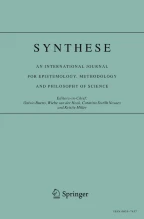Abstract
Connectionism and classicism, it generally appears, have at least this much in common: both place some notion of internal representation at the heart of a scientific study of mind. In recent years, however, a much more radical view has gained increasing popularity. This view calls into question the commitment to internal representation itself. More strikingly still, this new wave of anti-representationalism is rooted not in ‘armchair’ theorizing but in practical attempts to model and understand intelligent, adaptive behavior. In this paper we first present, and then critically assess, a variety of recent anti-representationalist treatments. We suggest that so far, at least, the sceptical rhetoric outpaces both evidence and argument. Some probable causes of this premature scepticism are isolated. Nonetheless, the anti-representationalist challenge is shown to be both important and progressive insofar as it forces us to see beyond the bare representational/non-representational dichotomy and to recognize instead a rich continuum of degrees and types of representationality.
Similar content being viewed by others
References
Abraham, R. H. and Shaw C. D.: 1992,Dynamics. The Geometry of Behavior, 2nd ed., Addison-Wesley, Redwood City, California.
Beer, R.: 1990,Intelligence and Adaptive Behavior, Academic Press, San Diego, California.
Beer, R.: to appear, ‘A Dynamical Systems Perspective on Environment Agent Interactions’,Artificial Intelligence.
Beer, R. and Gallagher, J. C.: 1992, ‘Evolving Dynamical Neural Networks for Adaptive Behavior’,Adaptive Behavior 1, 91–122.
Beer, R., Chiel, H. J., Quinn, R. D., Espenschied, K. S. and Larsson, P.: 1992, ‘A Distributed Neural Network Architecture for Hexapod Robot Locomotion’,Neural Comp. 4, 356–565.
Brooks, R.: 1991, ‘Intelligence Without Representation’,Artificial Intelligence 47, 139–159.
Churchland, P. M.: 1989,A Neurocomputational Perspective, MIT Press, Cambridge, Massachusetts.
Churchland, P. S. and Sejnowski, T. J.: 1992,The Computational Brain, MIT Press, Cambridge, Massachusetts.
Clark, A.: 1989,Microcognition, MIT Press, Cambridge, Massachusetts.
Clark, A.: 1992, ‘The Presence of a Symbol’,Connection Science 4 193–206.
Clark, A.: 1993,Associative Engines, MIT Press, Cambridge, Massachusetts.
Cleeremans, A.: 1993,Mechanisms of Implicit Learning: Connectionist Models of Sequence Processing, MIT Press/Bradford Books, Cambridge, Massachusetts.
Corbetta, M., Miezin, F. M., Dobmeyer, S., Gordon, L. S. and Peterson, S. E.: 1991, ‘Selective and Divided Attention During Visual Discriminations of Shape, Color and Speed: Functional Anatomy by Positron Emission Tomography’,The Journal of Neuroscience 11, 2383–402.
Dennett, D.: 1981,Brainstorms, MIT Press, Cambridge, Massachusetts.
Dreyfus, H. L.: 1991,Being-in-the-World. A Commentary on Heidegger's Being and Time. Division I, MIT Press, Cambridge, Massachusetts.
Elman, J. L.: 1991, ‘Distributed Representations, Simple Recurrent Networks and Grammatical Structure’,Machine Learning 7, 195–225.
Fodor, J.: 1975,The Language of Thought, Crowell, New York.
Fodor, J.: 1987,Psychosemantics. The Problem of Meaning in the Philosophy of Mind, MIT Press, Cambridge, Massachusetts..
Fodor, J. and Pylyshyn, Z.: 1988, ‘Connectionism and Cognitive Architecture: A Critical Analysis’,Cognition,28, 3–71.
Giunti, M.: 1992,Computers, Dynamical Systems, Phenomena and the Mind, Ph.D thesis, Indiana University.
Harcourt, A.: 1988, ‘All's Fair in Play and Politics’,New Scientist 108, 35–42.
Haugeland, J.: 1991, ‘Representational Genera’, In W. Ramsey, S. Stich and D. Rumelhart (eds.),Philosophy and Connectionist Theory, Erlbaum, New Jersey, pp. 61–90.
Heidegger, M.: 1962,Being and Time, Harper and Row, New York.
Hinton, G., Plut, D. and Shallice, T.: 1993, ‘Simulating Brain Damage’,Scientific American 269, 76–82.
Livingstone, M. S. and Hubel, D. H.: 1987, ‘Psychophysical Evidence for Separate Channels for the Perception of Form, Color, Movement, and Depth’,The Journal of Neuroscience 7, 3416–68.
McClelland, J., Rumelhart, D. and the PDP Research Group: 1986,Parallel Distributed Processing: Explorations in the Micro-Structure of Cognition, Vols. I and II, MIT Press, Cambridge, Massachusetts.
Newell, A. and Simon, H.: 1972,Human Problem Solving, Prentice-Hall, New Jersey.
Pinker, S. and Prince, A.: 1988, ‘On Language and Connectionism. Analysis of a Parallel Distributed Processing’,Cognition 28, 73–193
Port, R.: 1990, ‘Representation and Recognition of Temporal Patterns’,Connection Science 2, 151–76.
Rumelhart, D. and McClelland, J.: 1986, ‘On Learning the Past Tenses of English Verbs’, in J. McClelland et al. (eds.),Parallel Distributed Processing: Exploration in the Microstructure of Cognition, Vol. 2, MIT Press, Cambridge, Massachusetts., pp. 216–71.
Seidenberg, M. and McClelland, J.: 1989, ‘A Distributed, Developmental Model of Word Recognition and Naming’,Psychological Review 96, 523–68.
Smolensky, P.: 1988, ‘On the Proper Treatment of Connectionism’,Behavioral and Brain Sciences 11, 1–74.
van Essen, D., Anderson, C. and Olshausen, B.: in press, ‘Dynamic Routing Strategies in Sensory, Motor and Cognitive Processing’, in C. Koch and J. Davis (eds.),Large Scale Neuronal Theories of the Brain, MIT Press, Cambridge, Massachusetts.
van Gelder, T. J.: 1990, ‘Compositionality: A Connectionist Variation on a Classical Theme’,Cognitive Science 14, 335–84.
van Gelder, T. J.: 1991, ‘What is the “D” in “PDP”?. A Survey of the Concept of Distribution’, in R. W. Ramsey et al. (eds.),Philosophy and Connectionist Theory, Erlbaum, New Jersey.
van Gelder, T. J.: in press — a, ‘Is Cognition Categorization?’, in G. V. Nakamura, R. M. Taraban and D. L. Medin (eds.),Categorization by Humans and Machines, Academic Press, San Diego, California.
van Gelder, T. J.: in press — b, ‘What Might Cognition Be if Not Computation?’, in R. Port and T. J. van Gelder (eds.),Mind as Motion: Dynamics, Behavior and Cognition, MIT Press, Cambridge, Massachusetts.
van Gelder, T. J. and Port, R.: 1993, ‘Beyond Symbolic: Prolegomena to aKama-Sutra of Compositionality’, in V. Honavar and L. Uhr (eds), Symbol Processing and Connectionist Models in Artificial Intelligence and Cognition: Steps Toward Integration, Academic Press, San Diego, California.
Author information
Authors and Affiliations
Rights and permissions
About this article
Cite this article
Clark, A., Toribio, J. Doing without representing?. Synthese 101, 401–431 (1994). https://doi.org/10.1007/BF01063896
Issue Date:
DOI: https://doi.org/10.1007/BF01063896


